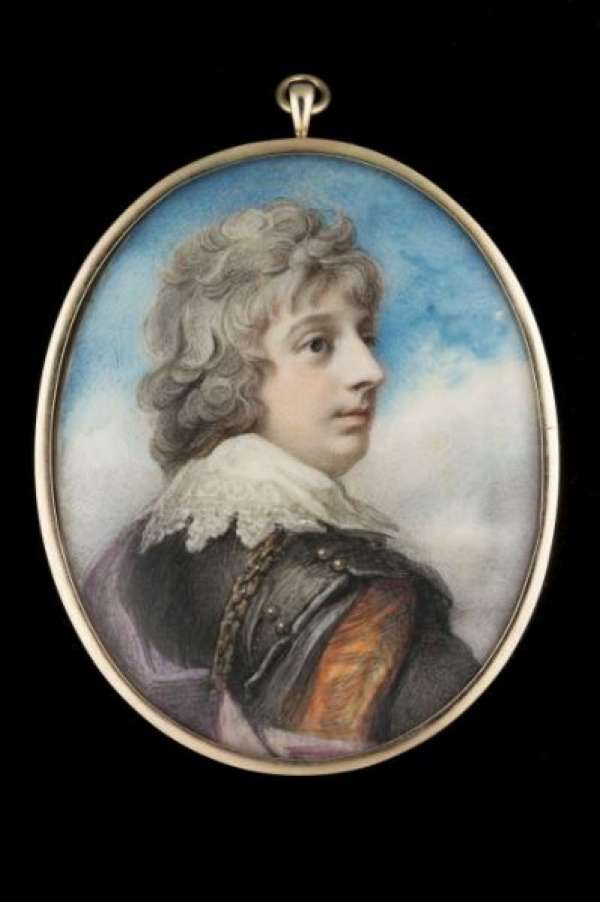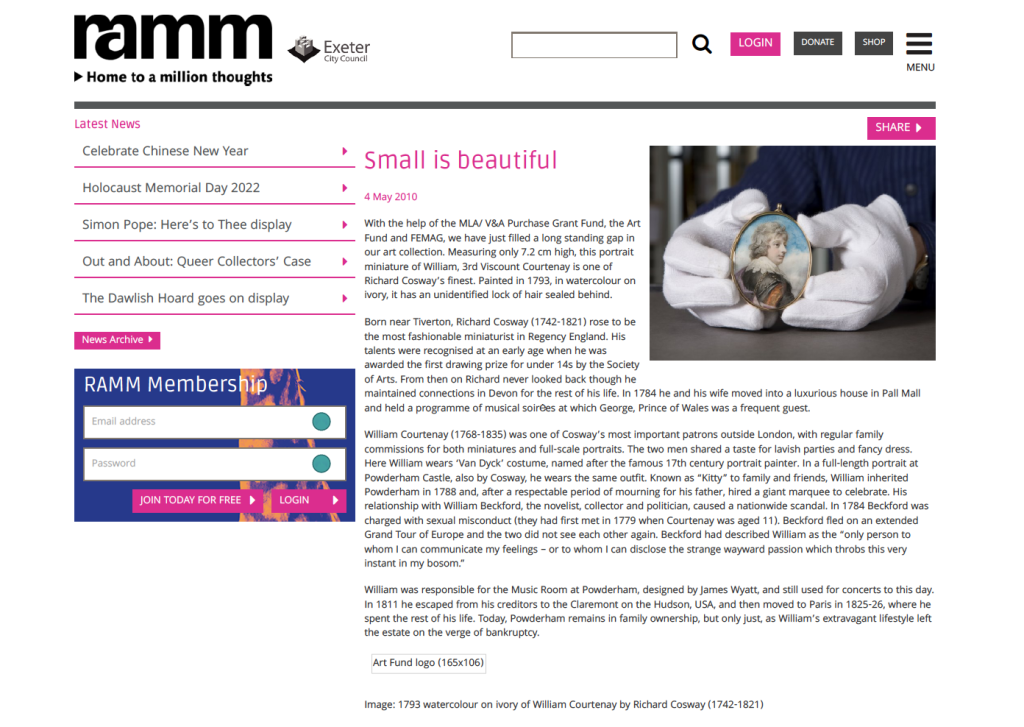
By Kathryn Edwards
In September 2020, I – Jana Funke – was invited to give a talk about the Out and About: Queering the Museum project at beautiful Powderham Castle in the village of Kenton, a 20-minute drive from the Exeter city centre. After the presentation, Charlie Courtenay, the 19th Earl of Devon, drew my attention to a description of a portrait miniature of his ancestor, William “Kitty” Courtenay, the 9th Earl of Devon, on the RAMM website.

Charlie pointed out that the framing of the object offered here was misleading. In particular, the insinuation that the 9th Earl of Devon threatened the family inheritance due to his “extravagant lifestyle” that allegedly “left the estate on the verge of bankruptcy” was not supported by the historical evidence. Presenting Kitty as wasteful, excessive and irresponsible plays into queerphobic stereotypes that we want to challenge as part of this project. This narrative did not originate with RAMM, but was perpetuated through the framing of the miniature. To correct this mistake, we have invited Kathryn Edwards, who has carried out extensive research on the life of the 9th Earl of Devon, to offer a different account of Courtenay’s life story, which you can read below. Our goal in doing so is not to erase or distract from the original framing of the object, but to make it visible and correct it at the same time.
William “Kitty” Courtenay 9th Earl of Devon
History has not always been kind to the 9th Earl of Devon. Family lore passed down for almost 200 years painted him as an uncaring, self-centred and extravagant man. This history claimed that the Earl fled the country due to debt and neglected his duties to his family and estate. This, compounded with an assumed affair with the gothic novelist William Beckford, has maligned his reputation ever since. However, recent archival discoveries reveal that he remained financially and emotionally committed to home and family even after fleeing due to an impending charge of “buggery”.
William Courtenay was born at Powderham Castle on July 30th in 1768, to Lady Frances and Lord William ( 2ndViscount) Courtenay. He was the 5th child born to the family and would be the only son of 14 children. It is believed that the 9th Earl had a relaxed, normal and happy childhood for a boy of his standing of the time. He spent most of his time between Powderham Castle and a home in Grosvenor Square in London. He also attended Westminster School from 1779 to 1784.
In 1811 the Earl found himself involved with rumours of charges against him for “buggery” with another man named William Fryer. Due to these impending charges, it was decided that the Earl should leave England for his safety. News reports of the Earls departure vary from him leaving different ports to leaving on different ships or his private yacht, whatever the case he landed in America.
Upon reaching America, the Earl set up residence in a place known as the Claremont, located in Manhattan, New York. It is doubtful that when the Earl chose America as the location to travel to that, he could have foreseen The United States declaring war against Great Britain and the beginning of the War of 1812. During this time, the Earl and his household were detained as enemy aliens. Due to the war, the Earl set sail in 1814 from New York to Paris, where he settled in Chateau Draveil, located a short distance outside of Paris. In France in May of 1835, the 9th Earl passed away from natural causes at the age of 66, having never returned to his beloved Powderham Castle.
In 2001, a series of letters were brought to the attention of the archivist at Powderham. Although these letters were found in 1970 located in a coal shed in London, it was not until 2001 when they were brought to the attention of Powderham. These papers later became known as the Wilkinson papers and shed quite a bit of light on the Earl’s life in Paris from 1823 to 1825. The Wilkinson papers are a series of letters written by John Wilkinson, a lawyer of London, while he was in the service of the Earl.
These letters rewrote the story that had been told about the Earl. He was far from uninterested and inattentive when caring for his family and his Estates. On the contrary, every matter concerning the family and the Estates was brought to the Earls attention, even minor issues. It was clear through these letters that even after 14 years of exile, the Earl exhibited a broad knowledge of his tenants and showed a keen interest in the welfare of his Estates. They also show great love for his family and his home at Powderham Castle.

A great read, I saw Kathryn’s talk on this subject at the castle and she presented it so well.
I work for the descendants of one of his sisters. The idea that Kitty was shunned by polite society I think is another queer-phobic slant on things, when I have read letters in which they talk about society parties and gatherings at his house.
Hello Claire
For the last few years I’ve been curating a website about William’s life and times: https://william1768courtenay.com. It would be great if we could come into contact with each other and share information about his family.
David
(I’m not at all confident we should be calling William ‘Kitty’. I’ve not seen any evidence that his contemporaries used that name; the only place where it appears is among the many falsifications in the Beckford papers, and it seems to be no more than a spiteful invention of that insecure, paranoid and malicious man in his old age.)
Is the miniature portrait stored back in the museum? Will this also be the only legacy of William Courtenay’s Miniature by Richard Cosway?
Tel-U